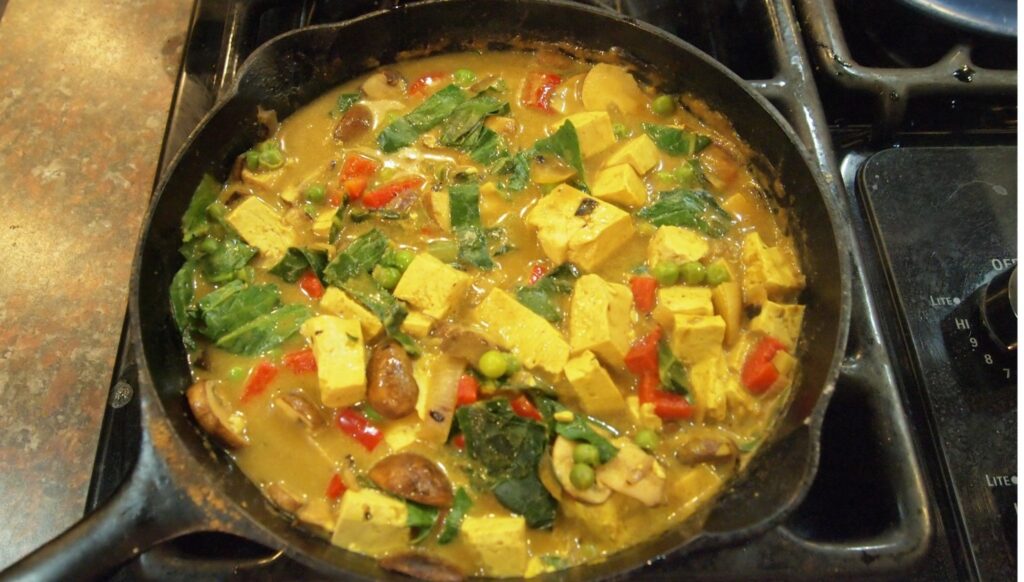Thai curry spices are more than just a pun-gent set of flavors.
Knock, knock.
Who’s there?
Curry . . .
Curry who?
Curry me back to Ole Virginny, or Curry on my Wayward Son for you Kansas fans.
Knock, knock.
Who’s there?
Curry . . .
Curry who?
Curry-osity killed the cat. [Thanks so much for the groans. I’m here through Thursday.]
The pun is one of the oldest forms of humor. It is also one of the highest intellectual forms of humor due to the depth of understanding a language and its connection to culture.
Curries are one of the oldest types of stews on record. First being mentioned in Babylon around 1700 BC. [i] And, according to my personal hierarchy of cooking skills, curries are one of its highest forms of culinary due to the spice complexities melding into a specific flavor.
The word, curry, is theorized to be an Anglification of a Sanskrit word, Kari. However, it appears that there are a number of words theorized to be the origin. All I know is that the tastes are multicultural and multi-dimensional. Oh yeah, I love them all!
In my search for the biggest health bang for the caloric buck, the spices used in curries are akin to finding The Nutrient Dollar Store. A pinch of this and a dash of that have been used for centuries to vanquish more than the common cold. In what follows, I choose my most favorite flavor enhancers and share their incredible properties.
Here’s the line up. You can read through the article and check out all of them or click and jump to what interests you:
- Cardamom
- Cilantro/Coriander
- Coconut Milk
- Cumin
- Fenugreek
- Galangal
- Garam Masala
- Kaffir Lime
- Lemon Grass
- Turmeric
Cardamom
This spice is used in the most unique ways from Indonesian curries to Scandinavian cookies. However, cardamom has been researched for use with chelation therapy. [ii] Chelation therapy is a treatment that uses specific drugs to remove metals such as lead, mercury, iron and arsenic from the body so they don’t make you sick. The antioxidant properties in cardamom showed positive results with metal removal as well as treating hypertension, kidney and urinary disorders. [iii] It also modulated gut activity and acted as a sedative. [iv] The evidence is fairly clear that I need to eat more cookies.
Cilantro/Coriander
Also known as Chinese parsley, people have a love/hate relationship with cilantro. Many times I have used it in my guacamole from my garden snippings. It can have a fabulous drying quality to flavors when used fresh. Watch out, though. There is also a whole swath of humans who taste cilantro as soap. Thus, when making guacamole for the general public I leave it out. Additionally, be aware that cooking can dull the cilantro flavor. Add it at the end of heating. [v]
The health aspects are numerous. The traditional use of cilantro to decrease hypertension is heavily supported in scientific literature. [vi] Historically, it has been used to treat diabetes, indigestion, rheumatism and joint pain. Current research is supporting its use to decrease blood glucose in diabetics, though the research is not conclusive. [vii] [viii]
Coconut Milk
We have all heard about the problems of coconut milk: high in saturated fat. Saturated Fat is what you find in butter and steak. Conversely, native cultures which regularly ingesting coconut milk do not show that use in cooking has any connection with heart disease. Studies divided traditional coconut eating subjects into those with coronary disease and those without. Results showed that animal product intake related directly to risk of coronary events, but not so with coconut milk in the meals. [ix] Obesity rates among Tanzania adults rose with a lower activity rate and high consumption of dairy milk, not coconut. Decreased obesity rates mentioned coconut milk as part of this regular diet. [x] If you like that creamy texture, use low-fat coconut milk. I just did another quick literature review about coconut milk and cholesterol. The jury is still out.
Cumin
That lovely dry heat which goes so well in my Aloo Gobi has been shown to kick butt when it comes stopping colon cancer cells [Pun intended, See Knock, knock] [xi] The property of cumin playing The Terminator role on cancer cells is Thymoquinone. Another fun name to put into the Charades basket at your next party – Factor-kappaß has been seen to initiate such diseases as cancer, atherosclerosis, myocardial infarction, diabetes, allergy, asthma, arthritis, Crohn’s disease, multiple sclerosis, Alzheimer’s disease, osteoporosis, psoriasis, and AIDS. [xii] Cumin, black cumin seeds in particular, have been put on a list of herbs which stop the manufacturing of this substance in your body. Check out my Morning Scramble recipe if you haven’t used cumin before.
Fenugreek
Although the most common method of calming infants in the United Arab Emirates was breast feeding, when asked to provide herbals teas that may be helpful, fenugreek was in the top five. Interestingly, 90% these mothers preferred not to use pacifiers, but themselves and their motherly instincts to help their babies through crying times. Historically, fenugreek has been used in the treatment of diabetes and current research appears to support this theory, although the evidence is not conclusive. [xiii] [ivx]
Galangal
Beginning its life in China and Java, galangal is similar to ginger. Its distinctive flavor not only gives a richness to Thai curries, but it has been traditionally used to relieve many GI tract problems such as bad breath, sea sickness, indigestion, ulcers and stomach inflammation, and diarrhea. This may be due to its antimicrobial properties. [xv] Like ginger it increases circulation especially to the hands and feet. [xvi] No wonder Tom Yum soup does the trick on colder nights.
Garam Masala
The term, “Masala”, means mixture. There isn’t a garam masala bush or tree. I include this to help you not have to shop for ingredients to make your own. However, not all masalas are the same. If you know your store, you can explain your taste preference and they may be able to assist in finding the heat and flavor mixture for your palate.
Kaffir Lime
In Southeast Asian cooking you may use the keffir rind or leaf in a recipe. Each has a sour flavor which works so well with the sweetness of coconut. Folk medicine uses the leaves as a gum disease prevention, and a digestive aid. The vodka company, Smirnoff, makes a mojito with kaffir limes and the beer company, Molson, flavors its Blue Moon line with the leaves. [xvii] Ponder that the next time you have a quaff of Blue Moon at your favorite watering hole.
Lemon Grass
The antifungal activity of lemon grass oil has been well documented. [xviii] Perhaps that is why it was considered a sacred herb and used by warriors. Its pungent taste comes from a chemical which also gives it antimicrobial qualities. The astringent properties not only help in wound health but promote gum and hair health. Sorry, no research seen about restoring hair to bald heads.
Turmeric
Not only will it make your tofu scramble a beautiful yellow color, but turmeric has detoxifying agents that lessen DNA damage and heighten DNA repair. Why does that matter? DNA is the map of your cells which is copied and then sent out to repair any damages. When DNA misreads, “I am an Ear Cell” for “Stick it in your ear gel”, the cell can mutate into a cancer cell. We want our DNA copy machine working with a perfectly cleaned plate and no paper clips.
With all of these incredibly tasty, cleansing, antioxidizing, fungi-eating actions going on with Thai curries, it is little wonder why gurus live so long and Thai restaurants have popped up everywhere. And that makes me one very happy gal.
Knock, knock.
Who’s there?
Curry . . .
Curry who?
Curry up and end this diatribe. We want to EAT! Don’t forget to tip your server.
In addition to the Morning Scramble recipe, try the Thai Green Curry recipe over your favorite grain.
[i] Grove P, Grove C. [2008] The origins of ‘Curry’ [is it really English]
[ii] Yadav, A. S., & Bhatnagar, D. (2007). Free radical scavenging activity, metal chelation and antioxidant power of some of the Indian spices. BioFactors (Oxford, England), 31(3-4), 219–227. https://doi.org/10.1002/biof.5520310309
[iii] Ballabh, B., & Chaurasia, O. P. (2007). Traditional medicinal plants of cold desert Ladakh–used in treatment of cold, cough and fever. Journal of ethnopharmacology, 112(2), 341–349. https://doi.org/10.1016/j.jep.2007.03.020
[iv] Gilani, A. H., Jabeen, Q., Khan, A. U., & Shah, A. J. (2008). Gut modulatory, blood pressure lowering, diuretic and sedative activities of cardamom. Journal of ethnopharmacology, 115(3), 463–472. https://doi.org/10.1016/j.jep.2007.10.015
[v] http://www.thaifoodandtravel.com/ingredients/cilantro.html
[vi] Jabeen, Q., Bashir, S., Lyoussi, B., & Gilani, A. H. (2009). Coriander fruit exhibits gut modulatory, blood pressure lowering and diuretic activities. Journal of ethnopharmacology, 122(1), 123–130. https://doi.org/10.1016/j.jep.2008.12.016
[vii] Dhanapakiam, P., Joseph, J. M., Ramaswamy, V. K., Moorthi, M., & Kumar, A. S. (2008). The cholesterol lowering property of coriander seeds (Coriandrum sativum): mechanism of action. Journal of environmental biology, 29(1), 53–56.
[viii] Eidi, M., Eidi, A., Saeidi, A., Molanaei, S., Sadeghipour, A., Bahar, M., & Bahar, K. (2009). Effect of coriander seed (Coriandrum sativum L.) ethanol extract on insulin release from pancreatic beta cells in streptozotocin-induced diabetic rats. Phytotherapy research : PTR, 23(3), 404–406. https://doi.org/10.1002/ptr.2642
[ix] Lipoeto, N. I., Agus, Z., Oenzil, F., Wahlqvist, M., & Wattanapenpaiboon, N. (2004). Dietary intake and the risk of coronary heart disease among the coconut-consuming Minangkabau in West Sumatra, Indonesia. Asia Pacific journal of clinical nutrition, 13(4), 377–384.
[x] Gali-Muhtasib, H., Diab-Assaf, M., Boltze, C., Al-Hmaira, J., Hartig, R., Roessner, A., & Schneider-Stock, R. (2004). Thymoquinone extracted from black seed triggers apoptotic cell death in human colorectal cancer cells via a p53-dependent mechanism. International journal of oncology, 25(4), 857–866.
[xi] Aggarwal, B. B., & Shishodia, S. (2004). Suppression of the nuclear factor-kappaB activation pathway by spice-derived phytochemicals: reasoning for seasoning. Annals of the New York Academy of Sciences, 1030, 434–441. https://doi.org/10.1196/annals.1329.054
[xii] Jetté, L., Harvey, L., Eugeni, K., & Levens, N. (2009). 4-Hydroxyisoleucine: a plant-derived treatment for metabolic syndrome. Current opinion in investigational drugs (London, England : 2000), 10(4), 353–358.
[xiii] Krishnaswamy K. (2008). Traditional Indian spices and their health significance. Asia Pacific journal of clinical nutrition, 17 Suppl 1, 265–268.
[vix] Huang, H., Wu, D., Tian, W. X., Ma, X. F., & Wu, X. D. (2008). Antimicrobial effect by extracts of rhizome of Alpinia officinarum Hance may relate to its inhibition of beta-ketoacyl-ACP reductase. Journal of enzyme inhibition and medicinal chemistry, 23(3), 362–368. https://doi.org/10.1080/14756360701622099
[xv] Retrieved from Curry Simple. What is Galangal?, 11/10/2022
[xvi] Wikipedia. [2009] Retrieved from http://en.wikipedia.org/wiki/Kaffir_lime on April 25, 2009
[xvii] Mishra, A. K., & Dubey, N. K. (1994). Evaluation of some essential oils for their toxicity against fungi causing deterioration of stored food commodities. Applied and environmental microbiology, 60(4), 1101–1105. https://doi.org/10.1128/aem.60.4.1101-1105.1994
[xviii] Organic facts Retrieved from https://www.organicfacts.net/health-benefits/herbs-and-spices/health-benefits-of-lemongrass.html 11/08/2022

